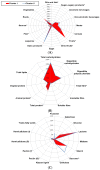Different Intestinal Microbial Profile in Over-Weight and Obese Subjects Consuming a Diet with Low Content of Fiber and Antioxidants
- PMID: 28555008
- PMCID: PMC5490530
- DOI: 10.3390/nu9060551
Different Intestinal Microbial Profile in Over-Weight and Obese Subjects Consuming a Diet with Low Content of Fiber and Antioxidants
Abstract
Obesity has been related to an increased risk of multiple diseases in which oxidative stress and inflammation play a role. Gut microbiota has emerged as a mediator in this interaction, providing new mechanistic insights at the interface between fat metabolism dysregulation and obesity development. Our aim was to analyze the interrelationship among obesity, diet, oxidative stress, inflammation and the intestinal microbiota in 68 healthy adults (29.4% normal-weight). Diet was assessed through a food frequency questionnaire and converted into nutrients and dietary compounds using food composition tables. The intestinal microbiota was assessed by quantitative PCR, fecal short chain fatty acids by gas chromatography and serum biomarkers by standard protocols. Higher levels of malondialdehyde (MDA), C reactive protein (CRP), serum leptin, glucose, fat percentage and the intestinal Lactobacillus group were found in the obese people. Cluster analysis of body mass index, fat mass, glucose, LDL/HDL ratio, leptin, MDA and CRP classified the subjects into two groups. The levels of the intestinal Bacteroides-Prevotella-Porphyromonas group were lower in the cluster and linked to a higher pro-oxidant and pro-inflammatory status, whose individuals also had lower intake of fruits, dried fruits, and fish. These results could be useful for designing strategies targeted to obesity prevention.
Keywords: antioxidant; microbiota; obesity; oxidative stress; western diet.
Conflict of interest statement
The authors declared no potential competing financial interests concerning this study. Funders had no role in study conception, design, analysis of the results or decision to publish.
Figures



Similar articles
-
Dietary intake of fat and fibre according to reference values relates to higher gut microbiota richness in overweight pregnant women.Br J Nutr. 2017 Sep;118(5):343-352. doi: 10.1017/S0007114517002100. Br J Nutr. 2017. PMID: 28901891
-
Improvement in cardiometabolic risk markers following a multifunctional diet is associated with gut microbial taxa in healthy overweight and obese subjects.Eur J Nutr. 2018 Dec;57(8):2927-2936. doi: 10.1007/s00394-017-1563-3. Epub 2017 Nov 2. Eur J Nutr. 2018. PMID: 29098426 Free PMC article. Clinical Trial.
-
Gut microbiota, dietary intakes and intestinal permeability reflected by serum zonulin in women.Eur J Nutr. 2018 Dec;57(8):2985-2997. doi: 10.1007/s00394-018-1784-0. Epub 2018 Jul 24. Eur J Nutr. 2018. PMID: 30043185 Free PMC article.
-
[Physiological patterns of intestinal microbiota. The role of dysbacteriosis in obesity, insulin resistance, diabetes and metabolic syndrome].Orv Hetil. 2016 Jan 3;157(1):13-22. doi: 10.1556/650.2015.30296. Orv Hetil. 2016. PMID: 26708682 Review. Hungarian.
-
[Simple obesity in children. A study on the role of nutritional factors].Med Wieku Rozwoj. 2006 Jan-Mar;10(1):3-191. Med Wieku Rozwoj. 2006. PMID: 16733288 Review. Polish.
Cited by
-
The Maternal Diet Index and Offspring Microbiota at 1 Month of Life: Insights from the Mediterranean Birth Cohort MAMI.Nutrients. 2024 Jan 20;16(2):314. doi: 10.3390/nu16020314. Nutrients. 2024. PMID: 38276552 Free PMC article.
-
Gochujang Ameliorates Hepatic Inflammation by Improving Dysbiosis of Gut Microbiota in High-Fat Diet-Induced Obese Mice.Microorganisms. 2023 Mar 31;11(4):911. doi: 10.3390/microorganisms11040911. Microorganisms. 2023. PMID: 37110334 Free PMC article.
-
Preliminary investigation on the association of dietary total antioxidant capacity, alternative healthy eating index, and dietary inflammatory index with intestinal microbiota in patients with diabetic nephropathy.Acta Diabetol. 2025 Jul 31. doi: 10.1007/s00592-025-02568-2. Online ahead of print. Acta Diabetol. 2025. PMID: 40742464
-
Nutrition and the Immune System: A Complicated Tango.Nutrients. 2020 Mar 19;12(3):818. doi: 10.3390/nu12030818. Nutrients. 2020. PMID: 32204518 Free PMC article. Review.
-
Whole Fruits and Fruit Fiber Emerging Health Effects.Nutrients. 2018 Nov 28;10(12):1833. doi: 10.3390/nu10121833. Nutrients. 2018. PMID: 30487459 Free PMC article. Review.
References
MeSH terms
Substances
LinkOut - more resources
Full Text Sources
Other Literature Sources
Medical
Molecular Biology Databases
Research Materials
Miscellaneous

